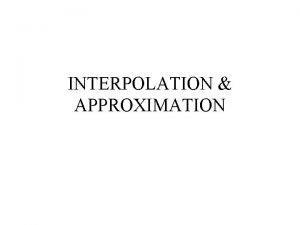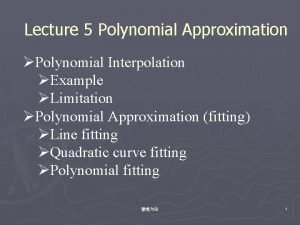Fitting rotation curves with a new interpolation formula

- Slides: 1

Fitting rotation curves with a new interpolation formula of MOND Gianfranco Gentile, Benoît Famaey, Hong. Sheng Zhao University of New Mexico (Albuquerque, USA, e-mail: ggentile@unm. edu), Université Libre de Bruxelles (Belgium), University of St. Andrews (Scotland) 1. Introduction 2. Results MOND is a successful way to fit rotation curves; even though there are cases where MOND fits are not successful in the details, it predicts impressively well the systematic kinematical properties of disk galaxies. In MOND the gravitational acceleration g and the Newtonian acceleration g. N are related through: g=g. N/μ(g/a 0) where μ(x) is an interpolation function such that: μ(x)→ 1 for g>>a 0 μ(x)→g/a 0 for g<<a 0 Traditionally μ(x) is given the following form: In order to test observationally the new μ(x), we fitted the 9 galaxies from the sample of Begeman, Broeils & Sanders (1991, MNRAS, 249, 523) and compared the outcome with the old μ(x). We chose this sample as it is considered as a "reference" sample for MOND fits. The results are shown in Fig. 1. The fits were performed by keeping the a 0 as a free parameter. We find : μ(x)=x/(1+x 2)1/2 (1) hereafter referred to as "old μ(x)". Recently, Famaey & Binney (2005, MNRAS, 363, 603) suggested an alternative functional form of μ(x) : μ(x)=x/(1+x) (2) hereafter referred to as "new μ(x)". One of the main advantages of this μ(x) over the old one is that, unlike the latter, it is not in contrast with the relativistic MOND theory (Bekenstein 2004, Phys. Rev. D, 70, 083509), as Zhao & Famaey (2006, Ap. J 638, L 9) have shown. Also, it manages to fit simultaneously the rotation curves of the Milky Way and of NGC 3198. - an average a 0= 1. 17 x 10 -8 cm s-2 with the new μ(x), very close to 1. 21 -8 -2 x 10 cm s given by the old μ(x). - The average χ2 new / χ2 old is 0. 96, very close to 1, i. e. the two μ(x) give the same quality fits. - The stellar M/L ratios, however, differ substantially: the average bestfit stellar M/L ratio with the new μ(x) is 35% lower than with the old μ(x). Keeping a 0 fixed at either 1. 17 x 10 -8 -2 cm s or 1. 21 x 10 cm s does not change significantly the results. Another observational test was made with the most extended rotation curve ever measured in terms of the optical disk (the rotation curve reaches 42 B-band exponential scale lengths), see Fig. 2. Both the old and the new μ(x) give good fits, with similar χ2. The best-fit M/L using the new μ(x) is 40% lower than by using the old μ(x). Fig. 1: Upper panels: rotation curve decompositions performed with the old μ(x) (eq. 1). Lower panels: rotation curve decompositions performed with the new μ(x) (eq. 2). Solid/dotted/long dashed/short dashed represent the best-fit rotation curve/disk contribution/gas contribution/bulge contribution. a 0 was kept as a free parameter. Fig. 2: rotation curve decompositions of the dwarf irregular galaxy NGC 3741. Its rotation curve extends out to 42 disk exponential scale lengths. Left: using the old μ(x). Right: using the new μ(x). a 0 was kept fixed at a value of 1. 21 x 10 -8 cm s-2. Conclusions - We tested observationally the new MOND interpolation function μ(x)=x/(1+x) proposed by Binney & Famaey (2005) - The new μ(x) fits the sample of Begeman, Broeils & Sanders (1991) as well as the old μ(x) - The best-fit stellar M/L ratios are ~35% lower than with the old μ(x)

